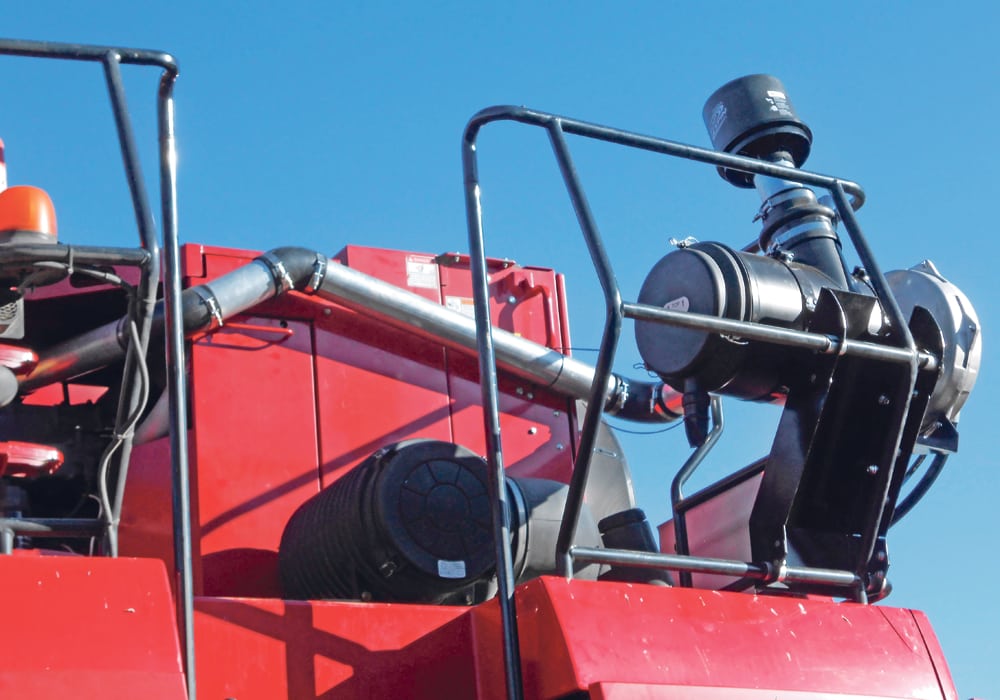A new system from South Dakota prevents the conditions that allow sunflower combine fires to get started in the first place
Sunflower debris in a combine ignites at temperatures 20 to 30 C lower than corn or soybean residue. However, most crops harvested in hot, dry weather can set your combine afire.
Armed with this fact, engineers at South Dakota State University developed an air filtration kit they think will prevent most combine fires that start while harvesting sunflowers.
Although their original project focused on sunflower machines, the device provides the same benefit to combines in less volatile crops.
The team, headed by retired ag engineering professor Daniel Humburg, saw that the dust and debris in a sunflower combine is from the white pith of sunflower stalks.
Read Also

Agritechnica Day 3: Hybrid drive for a combine, data standards keep up to tech change and tractors of the year
Agritechnica 2025 Day 3: Hybrid drive for a combine, data standards keep up to tech change and tractors of the year.
Humburg said the pith breaks down and is drawn into the fan pulling air through the engine radiator. When farmers combine sunflowers in windy conditions, they often find random smoldering fires on the side of the combine downstream from the radiator blast.
“A portion of this dust ignites when it hits the turbocharger and exhaust system,” Humburg said.
“Dust doesn’t even have to touch the hot component. Just coming close ignites some of the material when the machine is operating under heavy load conditions.
“Every once in a while one of these live embers lives long enough to land on a surface covered with the same dust. Then you have a fire. Once the fire starts, it’s easy for a spark to be relocated. Many machine components can burn, including fibreglass shields, wiring harnesses, flexible hoses and plastic fuel tanks.”
Sunflower growers told Humburg they manually find the engine’s sweet spot for each field.
Every unit of work you perform with an internal combustion engine creates heat. More performance means more heat through the exhaust system. So combine operators will monitor fuel use and rated engine load to pinpoint this sweet spot. Working the combine above this threshold fosters fires.
One sunflower grower told Humburg he has become attuned to the odour just before a fire ignites.
“He’s so sensitive to it that he knows exactly what to smell for to be on guard. This exemplifies the tension they’re under all the time. Farmers know that if they push combine engines beyond this threshold, they have a higher likelihood of a fire. A greater engine load will increase the exhaust system’s temperature.”
The SDSU device is intended to prevent ignition of dust at hot exhaust system components. It will not prevent fires that start from hot bearings, electrical shorts or friction that can cause high temperatures.
The kit centres around a fan to pull outside air through a filter. This clean air is pushed through a duct into sheet metal shroud surrounding the combine’s turbocharger and exhaust manifold. No pith elements can flow past or touch the exhaust system.
Humburg said surface temperature on the turbo hits 427 C (800 F) when the combine is working hard. Temperature on the outside surface of the metal enclosure surrounding the turbo is only 93 C (200 F), indicating that the dangerously high temperatures are indeed trapped within the sheet metal casing. Pith won’t ignite at 93 C.
He said the kit has been tested on several combine models over five harvest seasons and has successfully allowed farmers to use full machine capacity without fires, even during warm, dry harvest seasons.
However, Humburg said his system is not foolproof. Vigilance is still needed when harvesting sunflowers.
“I won’t tell producers they’ll never have a fire, but this stops the endemic smolders that originate at the exhaust system,” he said.
“Sunflowers are the poster child for fires around here, but I’ve also heard of fire issues in safflower and canola. I’d be interested to know what crops and conditions give your farmers the most challenges in terms of fires.”
Humburg said when he retired from SDSU he couldn’t find a company to manufacture and market the kits. So, in order to bring this technology to farmers, he started a company called DSH Engineering.
“I didn’t want to tell farmers that we’ve now found a way to prevent these combine fires, but you can’t have it. I wanted to at least get this off the ground to help farmers who were interested in growing sunflowers.”
Because of variations in exhaust systems, the design of the equipment is specific to different makes and models of combines. The equipment may also fit other models that use the same engine and exhaust system.
DSH makes kits for the John Deere 9770 and the Case 8230 and 8120. Humburg will add designs where possible to accommodate older machines and new Tier 4 models.
The kits cost US$4,250 plus applicable taxes.
For more information, contact DSH Engineering at 605 693-3761 or daniel.humburg@sdstate.edu.
















